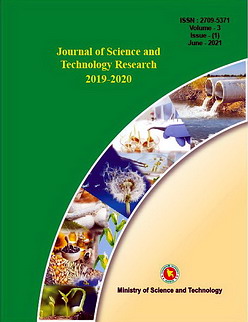Genetical and Physiological Analysis for Heat Tolerance in Spring Wheat
DOI:
https://doi.org/10.3329/jscitr.v3i1.62807Keywords:
Wheat; Genetic divergence; Heat stress and D2 analysisAbstract
The experiment was conducted at Agronomy field laboratory, Dept. of Agronomy and Agricultural Extension, University of Rajshahi, Rajshahi during 2019-2020 to identify the diverse genotypes of wheat related to heat tolerance. Twenty wheat genotypes/lines were used as a plant materials in this experiment. The wheat genotypes/lines were evaluated in heat stress environments. Non-hierarchical clustering grouped the wheat genotypes into five clusters. The cluster II indicated the maximum number of genotypes following the cluster V, III and IV. Plant height and spikes m-2 were major traits contributed mostly towards genetic divergence. Selection of parents for these two traits has good scope to get broad spectrum of segregates. The cluster V had the highest grains spike-1, spikelet’s spike-1, 1000-grain weight, grain yield and biomass whereas canopy temperature, heading days and maturity days were lowest. Cluster I had the lowest grain yield, spikes m-2, grains spike-1, biomass and chlorophyll content, plant height, spikelet’s spike-1 and 1000-grain weight. Five pairs of clusters viz. the clusters (I and V, I and II, I and IV, III and V and IV and V) may be considered for getting more heterotic F1. The genotypes G 02 and G 11 of cluster I and genotypes G 6, G 15, G 17, G 18 and G 20 of cluster V may be considered as parents for future hybridization program to obtain diverse genotypes related to heat tolerance.
J. of Sci. and Tech. Res. 3(1): 61-68, 2021
93
141
Downloads
Published
How to Cite
Issue
Section
License
Copyright (c) 2021 MS Alam, MM Rahman

This work is licensed under a Creative Commons Attribution 4.0 International License.




